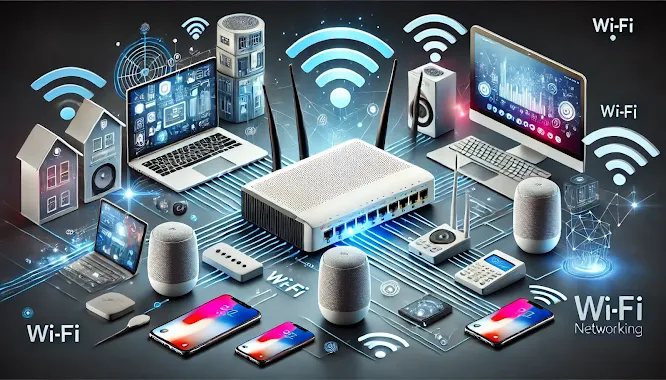Introduction to Networking: Connecting Your Devices
Networking is the backbone of our digital lives, enabling seamless communication and connectivity between devices. From streaming your favorite movies to automating your home, a strong network setup ensures everything functions effortlessly. In this guide, we will explore the basics of networking, including setting up Wi-Fi, understanding routers, and connecting multiple devices.
Understanding Networking Basics
What Is Networking?
Networking is the process of linking multiple devices to share data, resources, and internet access. It’s the foundation of modern connectivity, allowing computers, smartphones, printers, and smart devices to communicate and function as a unified system.
Why Is Networking Important?
- From Work to Entertainment: Networking facilitates essential tasks such as remote work, online gaming, video streaming, and file sharing.
- Smart Homes and IoT: Devices like smart thermostats, cameras, and voice assistants rely on a strong network to operate effectively.
Setting Up Wi-Fi
Choosing the Right Internet Plan
Start by selecting an internet plan that suits your household’s needs. High-bandwidth plans are ideal for activities like 4K streaming or gaming, while basic plans work for casual browsing and email.
Essential Hardware
- Routers vs. Modems: A modem connects to your internet service provider, while a router distributes the internet connection among your devices.
- Additional Devices: Use Wi-Fi extenders or mesh systems to enhance coverage in larger homes or areas with poor signal strength.
Step-by-Step Wi-Fi Setup
- Connect the modem to your ISP.
- Attach the router to the modem and power it on.
- Access the router’s admin panel to configure settings and secure your network with a strong password.
Understanding Routers
How Routers Work
Routers act as traffic controllers, managing the flow of data between devices and the internet. They ensure efficient communication and prevent data collisions.
Configuring Router Settings
- Login and Setup: Access your router’s admin interface through a web browser to configure network names, passwords, and other settings.
- Bandwidth Optimization: Use Quality of Service (QoS) settings to prioritize devices and applications that need consistent internet speeds.
Connecting Multiple Devices
Wired vs. Wireless Connections
- Wired Connections: Provide stable and fast speeds, ideal for gaming consoles, PCs, and streaming devices.
- Wireless Connections: Offer flexibility for mobile devices, though they may experience interference or slower speeds.
Managing Network Traffic
- Assign bandwidth priority to critical devices.
- Use dual-band routers to separate high-demand devices from regular ones.
Networking Security Tips
Securing Your Network with Passwords
Always use strong passwords with a combination of letters, numbers, and symbols to protect your network from unauthorized access.
Setting Up a Guest Network
Guest networks allow visitors to connect to the internet without accessing your primary devices, ensuring better security.
Advanced Security Protocols
Enable WPA3 encryption for robust security against potential cyber threats.
Optimizing Network Performance
Boosting Wi-Fi Speed
- Place your router in a central, elevated location to maximize coverage.
- Use the 5GHz band for faster speeds and reduced interference.
Reducing Interference
Keep your router away from devices like microwaves and cordless phones that can disrupt signals.
Monitoring Network Usage
Apps and router dashboards help you track and manage bandwidth usage, identifying devices that consume the most data.
Building a Smart Home Network
Connecting Smart Devices
Ensure your router supports the latest standards, such as Wi-Fi 6, to handle multiple devices efficiently.
Ensuring Compatibility
Verify that smart devices are compatible with your network before purchasing to avoid connectivity issues.
Conclusion
A robust and secure network is essential for modern living, powering everything from remote work to smart home automation. By understanding the basics of networking, setting up Wi-Fi correctly, and optimizing performance, you can ensure seamless connectivity for all your devices. With the right tools and knowledge, managing your home network becomes a hassle-free experience.
FAQs
1. How can I set up a secure home network?
Start by using a strong password, enabling WPA3 encryption, and setting up a guest network for visitors.
2. What’s the difference between a router and a modem?
A modem connects to your ISP, while a router distributes the internet connection to multiple devices.
3. How can I boost my Wi-Fi speed at home?
Place the router centrally, use the 5GHz band, and consider upgrading to a mesh system if needed.
4. What should I do if my network is slow?
Check for interference, reboot your router, or upgrade your internet plan to meet your household’s needs.
5. How do I connect multiple devices to one network?
Use a mix of wired and wireless connections, prioritize devices via your router’s settings, and consider extenders for larger areas.









Please write a feedback for the Post.
ReplyDelete